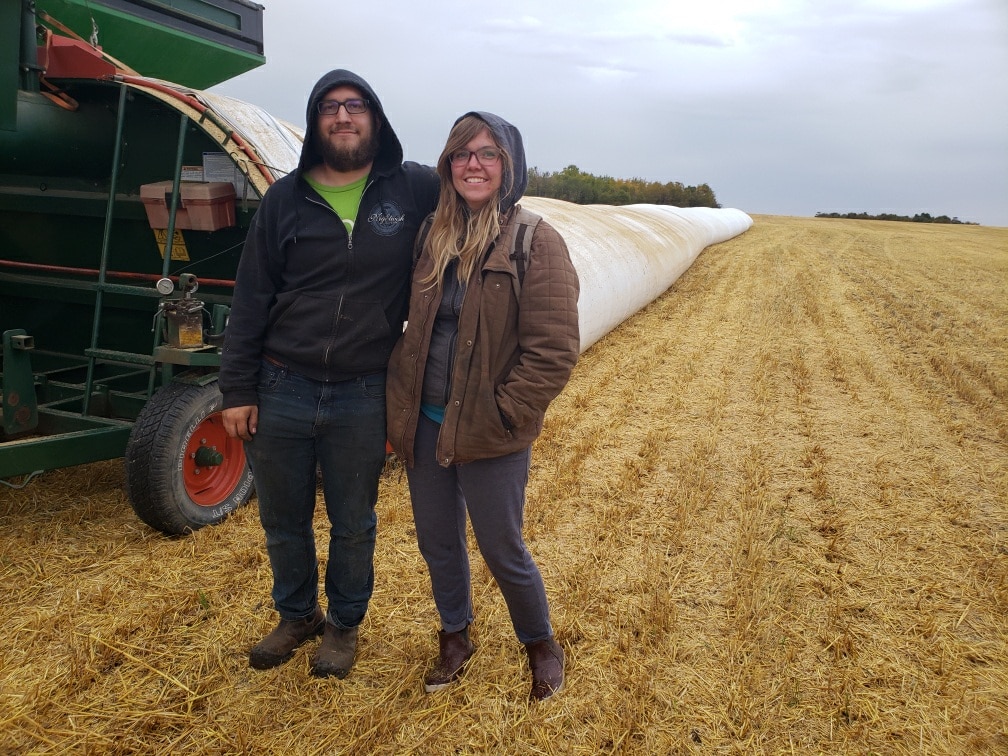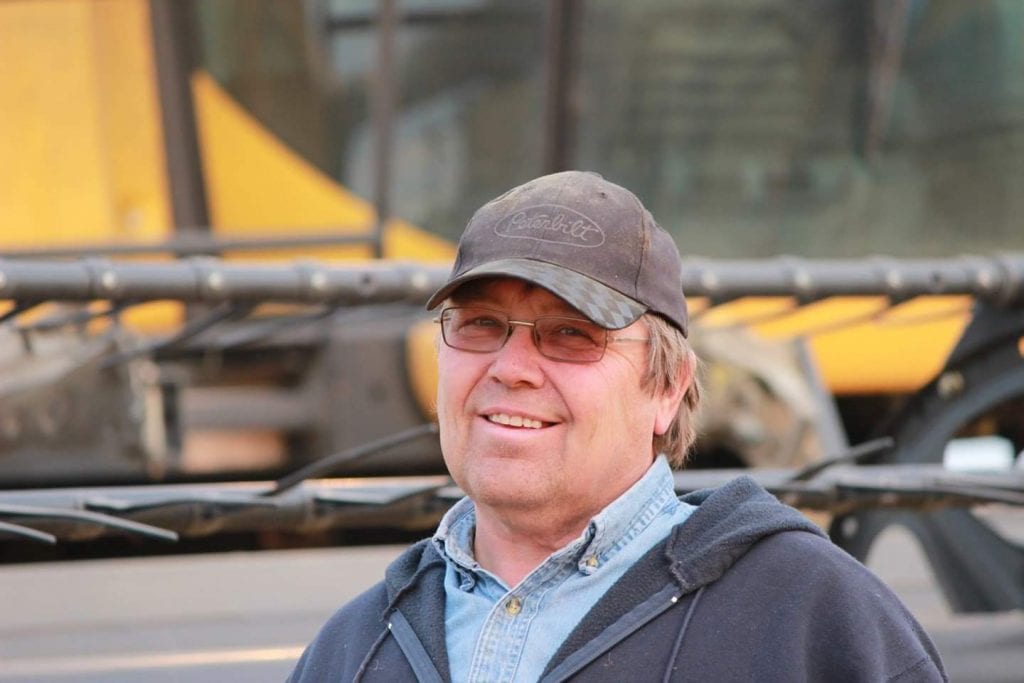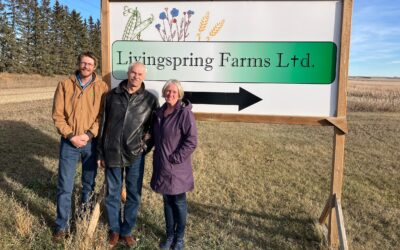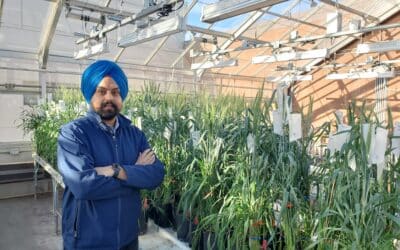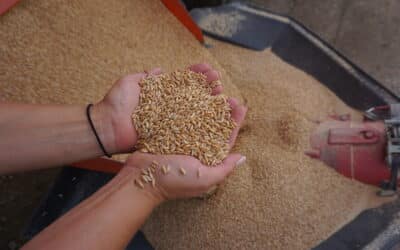Farmers come in two types: those who farm to live, and those who live to farm. Killam, Alta.-based seed grower Darrell Holmstrom is entirely the second.Though he has logged a full three and a half decades in the certified seed business, he’s just as excited about this year’s harvest as he’s ever been.
“You don’t know until you’re actually out there. It can look good when you’re walking the field, but you just don’t know until it’s actually coming down,” he says. “We had rain and rain and rain, but the barley looks incredible, and I’m amazed at the quality in the peas. I just want to get into it so we can see how some of our newer varieties did.”
Holmstrom has been growing pedigreed seed since 1985. Today, he grows 950 acres of pedigreed wheat seed, 350 acres of pedigreed barley, 330 acres of pedigreed green peas, and a few acres of both pedigreed oats and flax, as well as hybrid canola.
He’s particularly excited to be growing a new midge-tolerant CWRS wheat called AAC Wheatland. Unlike full-sized Unity, which he tried in 2010/2011 but found it had so much straw it kept the soil cold long into the following spring, AAC Wheatland is a strong-strawed semi-dwarf.
“We got amazing yields out of Unity. Amazing. But then we had frozen canola the next year, so it ended up costing money. What I like about Wheatland is that its yield potential is incredible, it stood up well through this year’s rain, and it doesn’t have the straw mass of Unity, so it’s not going to hold cold in the ground,” he says.
Watch for AAC Wheatland to launch in the fall of 2020.
He also grows ACC Elie, an early season, high yielding, semi-dwarf CWRS with good fusarium head blight resistance, and ACC Redberry, an early maturing, high yield and high protein full-size CWRS.
“Last year was a dry year, so a lot of Redberry got lodged in this year’s rains because of a carryover of fertilizer. It was pretty high-yielding, but you have to be careful about overfeeding Redberry. Elie, you can feed pretty heavy, so that was probably a better fit this year.”
Holmstrom’s barley acreage is divided between three varieties. The newest is CDC Fraser, a 2-row malting barley, which is impressing him so far with its “tremendously high” yields and decent standability. That said, this is just year one of growing the crop, so he’s not yet ready to make a definitive recommendation to growers.
“It’s looking like it’s on the heavier side of heavy. It looks excellent in the field but we haven’t got to it yet so I can’t make a definite judgement, and even then I won’t know for sure. It takes me about two to three years to really feel comfortable and confident recommending a variety.”
His top pick for peas is CDC Greenwater, a high protein, semi-leafless field pea that resists bleaching.
Given the number of varieties he’s growing of each crop type, administration and record-keeping are key. “Rotation is everything. We have to keep track of where we’ve been with everything,” he says. “Details are important in farming, especially if you’re a seed grower.”
Administration isn’t the only thing he is committed to doing right. From growing and harvest to cleaning and storage to final sale, Holmstrom believes in doing things well the first time.
“From my perspective, doing things the right way is always important. The right way is the right way. When a bin is clean, it’s not sort of clean or mostly clean, it’s clean. When things are done right, you can move on to the next thing confidently.”
He feels the same about his word.
“It all comes down to standing by what you do and what you say. I come from a family where that mattered. My dad had integrity. He passed it on to me and I tried to pass it on to my own kids.”
Holmstrom also believes deeply in the importance of supporting research, development and innovation. He was part of starting the Battle River Research Group out of Forestburg in 1987. He’s played a vital role in increasing seed stocks for various up-and-coming varieties at the Lacombe Research Station. And he has regularly handed over plots of his land for various research trials.
While his willingness to let researchers use his land is publicly beneficial, it’s not entirely altruistic: he believes he gets as much value from the trial as the researchers.
“Having trials done on my farm lets me learn from excellence. I see it as an investment in my own farm because it lets me get better myself. Rather than just thinking my own thoughts and using my own ideas, having a trial here means I can work with these top-level, behind the scenes people and learn from them to improve my own decision-making,” he says.
Allowing research to be done on his farm also means that he gains location-specific insight.
“You can’t always follow advice from another geographic location. You have to figure it out specific to your land. In my case, I benefit from excellent research minds helping me determine what will work best on my farm.”
What he learns via this research, he’s happy to pass on to other farmers.
“Being part of these trials helps me be a better teacher to my customers. All the information I gain, I’m a conduit to transfer that knowledge to other people.”
The information transfer isn’t only one way, of course.
“I love loading out trucks and talking with people. Big and small farms come here. Whether people buy a little or a lot of seed, we treat them all the same. I’ve learned a lot over the years by making time to listen to people.”
“We had people come for four pails of wheat once and they ended up talking for two hours. They were trying to do their best with very little. Other people come in for seed for 20,000 acres. We get all different types of people. They’ve all got something to say that’s worth hearing.”
Holmstrom Seed Farm services customers from as far as Manitoba and from southern to northern Alberta.
“The weather in this area treats us a bit better. We’re known for not getting too much frost, for being a little drier than other areas, which means our seed stock has good vigour,” he says.
Holmstrom and his wife, Barb, are proud that three of their five children have followed in their farming footsteps. The oldest daughter, Laurel, who happily drove the swather from age 12, began growing seed for Holmstrom Seeds this year with her husband, Dave. The third daughter, Jodi, and her husband, Phil, farm land nearby as well as working part time for Holmstrom Seeds. Youngest daughter, Rebecca, and her husband, Ryan, recently joined the family business full time while raising AB Cattlelac barley as seed and managing a herd of cattle.
“We’re in the process of transitioning to more family involvement on our farm,” says Holmstrom. “It’s good. It’s really good. But it takes effort to make that transition.”
The Holmstroms don’t just farm together, they sing — often in multi-part harmony — together, too. Holmstrom sees a lot of parallels between learning a new song and learning to farm together.
“Creating harmony together doesn’t automatically happen: you have to work at it and practice. You can’t just be thinking about your part, you have to appreciate that everyone has a different part. And when you start adding in extra parts — the kids’ spouses who have different backgrounds and different experiences — you have to figure out how they fit in. But it’s an amazing thing that happens when we get the harmony right.”


